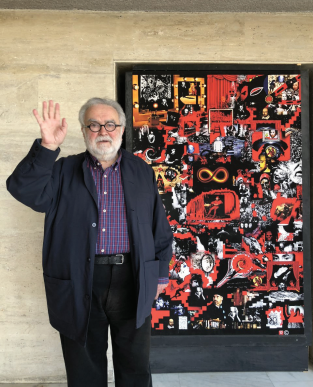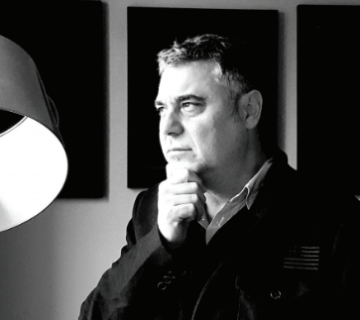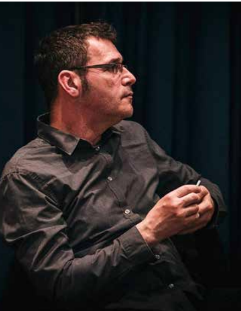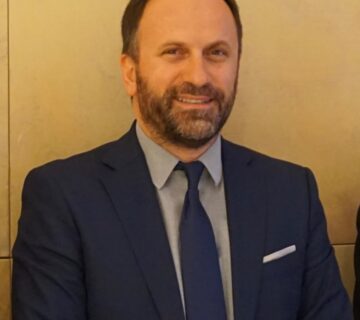George Banu was born in June 1943 in Buzău,
Romania and is a well-renowned theatre personality
and critic. He studied at the Academy of Drama and
Film in Bucharest, and permanently moved to Paris in
1973. Professor I.E.T. (Institut d’Etudes théâtrales) at
the University of Paris III, Sorbonne Nouvelle in Paris
and at the Theatre Studies Faculty of the University
of Louvain la Neuve in Belgium, Banu founded the
Experimental Theatre Academy in Paris in 1990,
together with Michelle Kokosowski, which he ran
until 2001, when the Academy’s activities ended. He
has made an impact in multiple functions: General
Secretary (1985-1992), President (1994-2000), then
Honorary President of the International Association of
Theatre Critics; he has also received various titles, such
as UNITER Member, Doctor Honoris Causa of the IL
Caragiale National University of Theatre and Film,
Bucharest in 2006, and Doctor Honoris Causa at
several other European Universities. He is a founding
member of Academia Balkanica Europeana
It all began in the mid 1960’s with Jan Kott’s Shakespeare, Our Contemporary, the book announcing the great “rapprochement” between the works of the past and the widely adopted sacrifices of timelessness regarding the classics. Peter Brook was impacted by Kott’s approach, which was determined by both WWII and the newly successful theater of Beckett, and he then directed King Lear – the turning point of his career. From then on, Shakespeare will be directly associated with the condition of the modern man and a large number of productions will bear the mark of this mutation which, for a short period, will take on a more radical form under the influence of this devastating group which was the Living Theatre, and which performed an Antigone that has since become famous for the complete integration of Greek tragedy into the movement typical of the 1968 generation: total resistance to political power! This work of Sophocles is part of the pursuit of the largely prevailing willingness to engage in the suppression of its distance and prestige in order to free ourselves of what Brecht called “the intimidation of the classics.” They become closer to us, familiar, connected with the destinies of the contemporary world. Grotowski, on the other hand, will turn away from this tendency in order to focus on what he calls the eternal “core” of the human condition which he tries to identify at the heart of the classics. Here is the third hypothesis: it will be accomplished by what remains his masterpiece, Calderón de la Barca’s The Constant Prince in its Juliusz Slowacki version. From the recognizable immediacy to the distanced strangeness – two extremes between which the mise en scene evolves, free from the authority of the classics.
In the grasp of this exemplary antimony can be found the best performances of the years following the seism of 1968, the Hamlet of Youri Lioubimov, Lorenzaccio by Otomar Krejca, Radu Penciulescu’s King Lear…always closer, always closer. This exacerbation of closeness will receive a counter move twenty years later, a truly polemic denial of the previously adopted position. “Nothing should be treated as our contemporary,” declared Ariane Mnouchkine, who would go on to stage two cycles, the Atreids and the Shakespeares, using traditional, mostly oriental forms of theater. Their beauty and the perfection of their movements, of their costumes, the link with music, allowed them to attain a timeless theatricality, splendid and mesmerizing. Nothing contemporary here… And this approach, even though it takes a different stance, can be found also in the famed Oresteia by Peter Stein which manages to rediscover the structural principles of Greek tragedy as it was originally put on stage. He does not fall into an artificial reenactment, he simply revives the past of the stage as a Mother Earth of ancient texts. From then on, distance is nurtured at the expense of proximity. Only Klaus Michael Grüber will come close to Grotowski, constructing his mythic oeuvre with The Bacchantes as a reflection on the endlessness of the fight with the occult, obscure forces, which have rid themselves of the power of reason, plunging bright and clear certitudes into doubt. The Bacchantes, lying beyond the rejected proximity and the discarded distance, establishes itself as the great antique play of modernity.
The pendulum of time intervenes and thus the strangeness of the distancing replaces the contemporary familiarity previously so affirmed, it is distance that succeeds closeness…and the texts are brought back to light like what Antoine Vitez so beautifully called “the sunken gallions.” Those wrecked ships, heavy with the poetry of ancient times, assert themselves as refractory to the avowals of the immediate that we previously wanted to subtract from the classical texts. Historicity and contemporaneity – this is the contradiction for which the mise en scene of the classics has become a battleground.
The bringing up-to-date will be contested and history will be rediscovered – but not timelessness! – this displacement will provoke a turning back toward the source of the texts thanks to new translations which, for the time being, have no desire to be subjected to the violent operations of rewriting, but nevertheless inject the breath of modern languages, a true challenge for the stage. From then on, directors will adopt a respect for the texts and give up their old disdain (cutting out bits, removing pieces) which would, in turn, require a linguistic rereading of the works, be they Greek or Shakespearean. From the stage, we no longer hear 19th century language but a new one, close yet distant. This act of writing served as a preliminary condition for the renewal of the performances from then on, due to completely revised literary material. As proof, we have the production of Electraby Antoine Vitez, who is also the author of the translation. A performance which puts together temporal contradictions and is based on a version of the work which is free from ancient rhetoric. A performance which recreates the original dimension of the tragedy in the context of a scenography and a vocabulary, both of which, together, liberate it from any kind of “intimidation” coming from its old prestige. This revision transpires through the translations and the devotion toward the ancient “new texts!”
The next generation of theater directors, in the beginning of the century, continue to go back to the classical texts and plunge into this imaginary museum of theater which is their great repertoire. And then, with the movement of the pendulum typical of modern art, the cult of “presenteeisme” appears, wreaking havoc for the last ten years to the point where it created scenarios improvised by teams of actors relying only on the immediately contemporary. Still, the most significant figures, Ostermeier, Warlikowski, Ivo van Hove, distanced themselves from this…but they explicitly wished to intervene in the text and they do it without hesitation. If before, at the time of Brook or Grotowski, texts were simply reduced, cut, lately lines inspired by present-day context, debates and steamy controversies are being inserted in them: the classics become outspoken hybrids, thus the texts ring impure, patched, twisted. This produces obvious resemblances, but sometimes we cannot prevent ourselves from deploring this hodgepodge of writing as a whole. And even more so because it seems to be becoming a standard…putting a moustache on the Mona Lisa, like Duchamp, can be astounding once, but turning this into common practice will end up nurturing a reserved attitude, which could even end up being detrimental. The present, injected in too brutal a way, reflects a voluntarism which reduces the openness of the texts as well as affecting their intrinsic qualities. And all this in order to impose a very, or too explicit presence of the authors of those plays, who thus aim to discuss, in a very excessively direct manner, with the audience. But they forget that the way theater, and the stage, work has to do with detour as an artistic strategy. I like to see the present in the original text, but I deplore the implant when it is too obvious.
One of the most pertinent solutions consists of finding representation devices which, when activated, relate to present-day experiences. We recognize the great texts, but in a context which brings to light a different perspective, an unexpected one, like in Ivo van Hove’s masterpiece The Roman Tragedies, where he puts together three Shakespearean texts according to the principal of the TV series, where we can see the filming and follow suit: like spectators in a studio, each one of us is free to move about, to choose our spot and, at the same time, if the story interests us, to stand still. The modernness of such a “large-scale” show perturbed the habitually respected codes of representation. Warlikowski, in turn, also linked Shakespearean texts in a cycle of three plays under the title African Tales… thus succeeding in putting forth similarities and echos from one play to the next. But what remains his biggest success is Apollonia, where motifs from Greek tragedies find themselves intertwined with extracts of current texts – for instance Agamemnon’s unforgettable war report upon his return borrows a long fragment from The Kindly Ones by Jonathan Littell – extracts that evoke the experiences of present-day generations. In view of this, Guy Cassiers radicalizes his approach by leaning on the matrix of “rewritten” ancient tragedies by an admirable Flemish writer, Tom Lanoye. He does not bow to the established model of using a myth to write a new text, he proceeds to a “fabrication” which ends up creating a text marked by the seal of modern language and certain present-day references. Thus one of the most admirable works of intertexuality which exceeds by far the humble hybridization certain directors employ – poor writers, mired in reality.
The effect of this new frame of representation can be felt in the extraordinary Merchant of Venice, for which Peter Sellars was inspired by the Los Angeles riots and turned Schylock into a black businessman banned by the association of white bankers…and then the trial scene grabbed us by the throat with its immediacy as well as with its revival of very recent history. Peter Zadek put on stage the same infernal text in reference to the struggles of the Deutsche Bank in Germany after the Fall of the Berlin Wall. Other directors opted for the “hospital” device as a frame of representation in order to give the tragedy a global resonance: the world is sick! Unfortunately, with those outstanding successes came the superficial effects of modern times, the true status symbols – tattooed arms, eccentric hairstyles, age-specific outfits…superficially added on the outside to highlight the desire to be up-to-date, which brings with it what is most artificial! Such updating is the degraded, “light” version of contemporariness!
But to follow the movements of the pendulum, some directors, mostly French, as far as I know, manage nowadays to stand at a distance, sometimes to excessive extremes, in order to not associate it with history, but to give it an imaginary, dreamlike dimension. In a series of Shakespearean performances, Thomas Joly conceived a strange and extravagant world, a world that expresses a rejection of the present by painting landscapes of an unknown distant past. That past is fiction.
Between those two extremes, Ivo van Hove has found a balance, fixed and tense, in one of the biggest recent successes of the European stage Kings of War. He resumes the “series” principle, blending three Shakespearean chronicles as if they were news reports on war and current struggles for power. It all refers to modern political ferociousness…but Ivo van Hove is not satisfied with that all too obvious comparison and he conserves the ancient, historical elements that can confirm the ancientness of the works and their original mode of representation: royal crown, scepter, throne, a red carpet in the midst of a hospital, the intimacy of the stretcher-bearers, the resuscitation devices. In this way, an unexpected alliance is formed, which proves that this text is indeed a text of the past, but nourished with the avatars of the present. They coexist. The performance connects them and the audience find themselves at the crossroads of continuity. Of distance and proximity linked together. Neither the long-sighted perspective of the sky, nor the short-sighted view of the microscope!
Translated from French by Velina Minkoff







